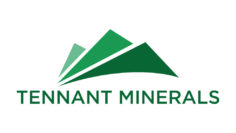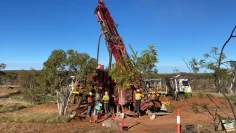{australien_flagge}New thick copper intercepts indicate that high-grade mineralization at Tennant Minerals’ (ASX: TMS; FRA: UH7A) Bluebird copper-gold discovery continues at greater depth than initially thought. This is the main result of the recent three diamond drill holes (13 to 15) which intersected the mineralization a further 100 m deeper to the west on a steeper orientation. Mineralization has now been traced more than 250 m below surface. Laboratory assays from the above drilling are not yet available. Confidently, Bluebird’s steep geometry is similar to other large deposits in the historic Tennant Creek mineral field. Bluebird is part of the Barkly Project, 45 km east of the Tennant Creek community in the Northern Territory and on the eastern edge of the Tennant Creek copper-gold mineral field.

Figure 1: Bluebird longitudinal projection showing previous high-grade copper-gold hits and current intercepts.
The deepest hole to date at Bluebird, BBDD0015, intersected 62 m of hematite-silica alteration, including a 20 m zone of specular hematite and copper mineralization (malachite, native copper, chrysocolla and copper sulphides) at 277 m depth. Significantly, the iron oxide alteration and copper mineralization intersected in BBDD0015 has changed orientation and now dips steeply to the north. This steep plunge of the mineralized zone at depth indicates that some previous drilling stopped short of the main high-grade zone, which may extend much deeper than previously thought.
Diamond drill hole BBDD0013 tested extensions west of the previously reported 55 m interval of strong to intense hematite and copper mineralization in BBDD00121 (assay results pending – see Figure 1 for drill point locations) and intersected a 46 m zone of hematite alteration, including 21 m of intense hematite-magnetite and copper mineralization (native copper and chalcocite) at 157 m hole depth.
BBDD0014 tested the upper part of the Bluebird mineralized zone (Figure 1) and intersected 34 m of hematite-silica alteration, including a 16 m zone of copper mineralization at 130 m depth.
Currently, the next phase of diamond drilling is already underway. The next two to three holes will focus on testing the Bluebird mineralization to the west and at depth. Electromagnetic (DHEM) drilling will then be conducted from the deepest holes to determine the geometry of the extensions to the Bluebird mineralization before initiating the Phase 2 step-out drilling program.
Drone magnetic processing and modeling to define several additional copper-gold targets along the broader 5 km Bluebird corridor is nearing completion. New imagery and inversion models of the new magnetic data will be combined with the previous gravity inversion model to define priority drill targets along this corridor. The results of these important programs will enable the Company to target Phase 2 step-out drilling at Bluebird and test other key targets within the 5km Bluebird corridor to unlock the true potential of this copper-gold discovery in this historic and well-endowed mineral field. Phase 2will include 10 step-out holes for 3,000m. This is expected to extend the extent of the Bluebird discovery to a strike length of over 300m and a vertical depth of over 300m.

Figure 2: Location of the Barkly Project and major historic mines in the Tennant Creek Mineral Field.
Summary: The Bluebird discovery begins only 60 m below surface (see Figure 1) and to date has only been tested to a depth of 250 m. The Bluebird discovery is not known to be open to the west. However, it is already known that the mineralization is completely open at depth and to the west. There is therefore considerable potential for the Bluebird discovery to continue at depth and to be of a similar scale to other known deposits in the region. Bluebird has similar dimensions, geometry and mineralogy to Castille Resources’ (ASX: CST) Rover 1 discovery in the southwestern portion of the Tennant Creek mineral field. Like Bluebird, Rover 1 mineralization exhibits a moderate to steep dip that continues for 500 m to depths ranging from 300 m to 850 m below surface. Castile recently reported a resource of 4.7 million tonnes at 1.63% Cu and 1.73 g/t Au for the Rover 16 deposit. Other examples of typical Tennant Creek deposits include the Warrego discovery at Peko-Wallsend, which from 1972 to 1989 produced 6.75 million t at 1.9% Cu and 6.6 g/t Au, and the Peko deposit, just 20 km west of Bluebird, which produced 3.67 million t at 4% Cu and 3.5 g/t Au7 from 1954 to 1976 (see Figure 2).
Disclaimer: GOLDINVEST Consulting GmbH offers editors, agencies and companies the possibility to publish comments, analyses and news on https://www.goldinvest.de. These contents serve exclusively the information of the readers and do not represent any kind of call to action, neither explicitly nor implicitly they are to be understood as an assurance of possible price developments. Furthermore, they in no way replace an individual expert investment advice, it is rather promotional / journalistic publications. Readers who make investment decisions or carry out transactions on the basis of the information provided here do so entirely at their own risk. The acquisition of securities, especially with shares in the penny stock area, carries high risks, which can lead to a total loss of the invested capital. The GOLDINVEST Consulting GmbH and its authors expressly exclude any liability for financial losses or the content guarantee for topicality, correctness, adequacy and completeness of the articles offered here. Please also note our terms of use.
According to §34b WpHG and according to paragraph 48f paragraph 5 BörseG (Austria) we would like to point out that principals, partners, authors and employees of GOLDINVEST Consulting GmbH hold or may hold shares of Tennant Minerals and therefore a possible conflict of interest exists. We also cannot exclude that other stock letters, media or research firms discuss the stocks we recommend during the same period. Therefore, symmetrical information and opinion generation may occur during this period. Furthermore, there is a consulting or other service contract between Tennant Minerals and GOLDINVEST Consulting GmbH, which means that a conflict of interest exists.











